From robotics to revenue: How Stäubli is scaling software using software licensing
Swiss precision meets software speed
For over a century, Swiss engineering has meant one thing: precision. Stäubli embodies this legacy—with 2,000+ patents, 6,000 employees across 28 countries, and robotic arms trusted in the world's most demanding environments, from automotive assembly lines to pharmaceutical clean rooms.
Stäubli's software portfolio reflects the same commitment to innovation as their hardware. The Stäubli Robotics Suite enables customers to program, simulate, and optimize entire robotics projects before a single physical robot moves. Their SCOPE monitoring platform performs predictive maintenance analysis, catching potential issues before they disrupt production lines. These aren't just software add-ons—they're strategic platforms that extend Stäubli's value proposition far beyond the physical robot.
But as the industry shifted to software-led growth models, Stäubli faced a challenge familiar to many industrial leaders: how do you transform decades of hardware expertise into scalable software revenue? Success required a fundamental shift in how Stäubli monetized and delivered their digital products.
From three-year cycles to continuous monetization
Stäubli releases major versions of its Robotics Suite every three years—but they didn't want to wait three years to monetize new innovations. Between releases, the company wanted to continuously launch feature upgrades, configure dynamic upsells, and offer specialized pricing like preferred university rates.
Physical dongles made this impossible. You can't ship hardware keys for every pricing experiment or feature toggle. Manual processes locked Stäubli into rigid packaging decisions and created weeks-long delays for customers who needed instant access to new capabilities.
By moving to digital licensing, Stäubli gained the flexibility to package and price software much like an agile SaaS company —launching features on-demand, testing new models, and turning software into a continuous revenue engine rather than a three-year cycle business.
Moving faster didn’t mean taking bigger risks. With expert support, Stäubli packaged and deployed new software in just eight days, with six months of dedicated follow-up ensuring smooth rollout. The launch of its predictive maintenance platform, SCOPE, proved the model: quick to market, secure by design, and ready to scale globally.
Scaling at the speed of software
Once freed from logistical bottlenecks, Stäubli shifted its focus to growth. What once took weeks to deliver now reached customers in minutes. The company gained the agility to package features dynamically, trial new pricing models like freemium pilots and academic programs, and launch upgrades between major releases.
That commercial flexibility became a competitive edge: customers enjoyed faster access and more choice, sales teams had new levers to drive adoption, and Stäubli was able to capture value more quickly from every release.
Building a subscription-ready future
For Stäubli, digital licensing isn’t the finish line — it’s the foundation for what comes next. The company is preparing to expand beyond perpetual models. It has it’s eyes set on offering subscriptions that lower upfront costs for customers while creating predictable, recurring revenue streams. E-commerce delivery is also on the horizon, opening new ways to reach global buyers and make software as easy to adopt as it is to use.
By turning licensing from a bottleneck into a growth lever, Stäubli has proven that a robotics company can operate at speed and monetize like a software business.




